Unusual brick houses. Modern and beautiful brickwork
The construction of buildings is often made from a practical material - brick. For most, brick is an ordinary stone; few people see it as an aesthetic material.
Today there is a variety of finishing materials for finishing facades. But they all require knowledge to work with them, and ordinary brick will not only help you save on finishing materials. You can easily create patterns using brickwork. It will look beautiful, a professional mason will be able to lay out a real masterpiece.
Necessary solely for beauty. Here you can show your imagination and create a façade that is unlike others.
Facing bricks can be laid in three ways:
- Straight masonry, where the pattern of the brickwork is achieved by tying the bricks together.
- Decorative masonry, where different color options of bricks are used.
- Artistic masonry. Not only various elements of straight and decorative masonry are used, but also relief patterns. There are notches, protrusions, slopes and bends.
Knowledge of the features of decorative masonry is important not only for self-installation brick pattern. It is important to competently explain to the master what you want to end up with on the façade wall. If you cannot express your wishes exactly, the result may not meet your expectations.
Variations of brickwork
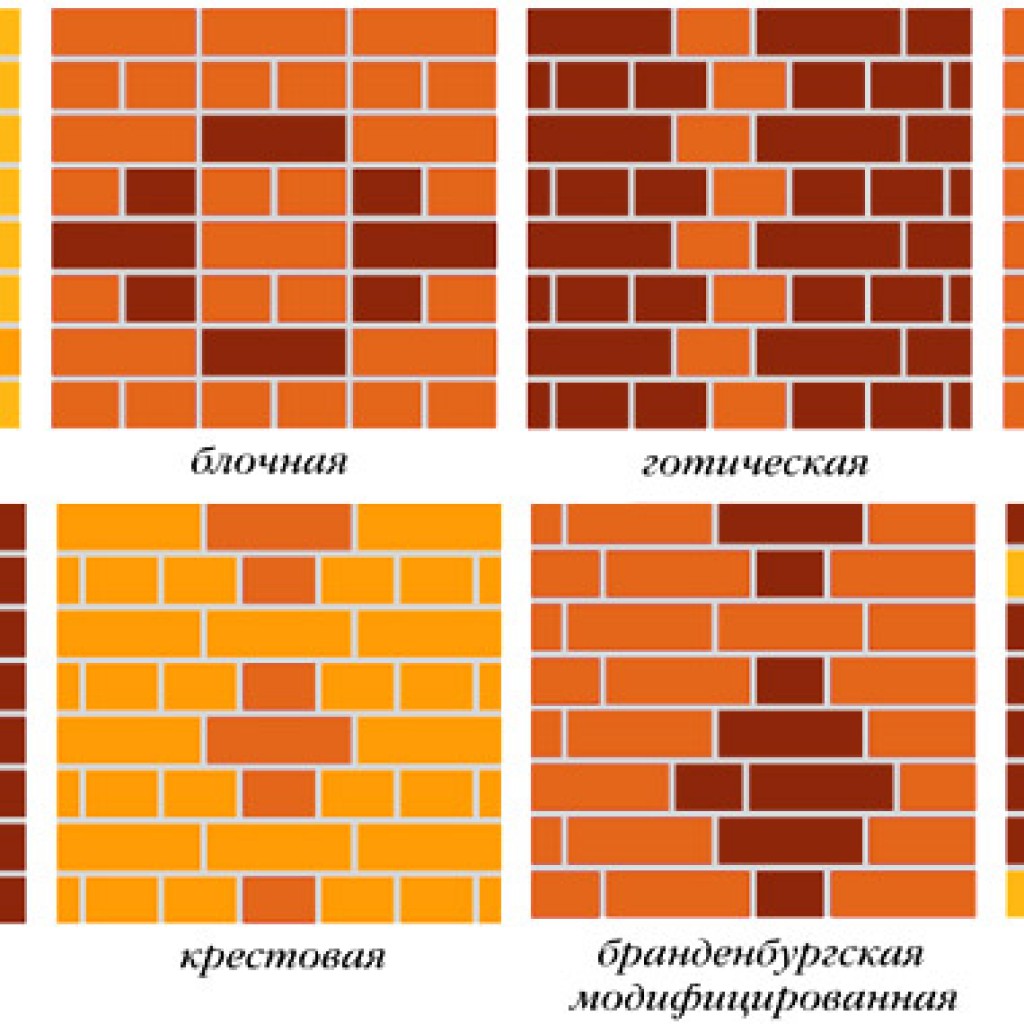
Brickwork patterns can be done in any way proposed by construction companies. The easiest way to decorate the facade of a building is to try to modify the seams between the bricks. Seams can be concave, convex, multi-colored. They can be decorated with glass and crumbs. (You can read more about this at the link)
Relief masonry is very popular. With its help, you can decorate your door or door in an original way. To do this, you need to slightly push the bricks out, deviating from the initial placement of the row of bricks. , especially in the kitchen, looks impressive.
How to create patterns from brickwork? There are many different pattern options. The pattern itself is easier to create by alternating several colors of brick. To form a pattern, you can use embroidery pattern diagrams. Brick does not repeat square shape, however the diagram may help with the brick laying idea.
The so-called Polish masonry is also very popular, which involves alternating rows of bricks with interlocking and interlocking sides. This requires some skill and experience as a mason. If you see the facade of a house in the style of Polish masonry, then you should contact a specialist who knows the features and varieties of this type of masonry.
Decorative brickwork does not require additional cladding. This saves money and time. The appearance of relief or decorative masonry looks very interesting on the facade.
Brickwork ornament
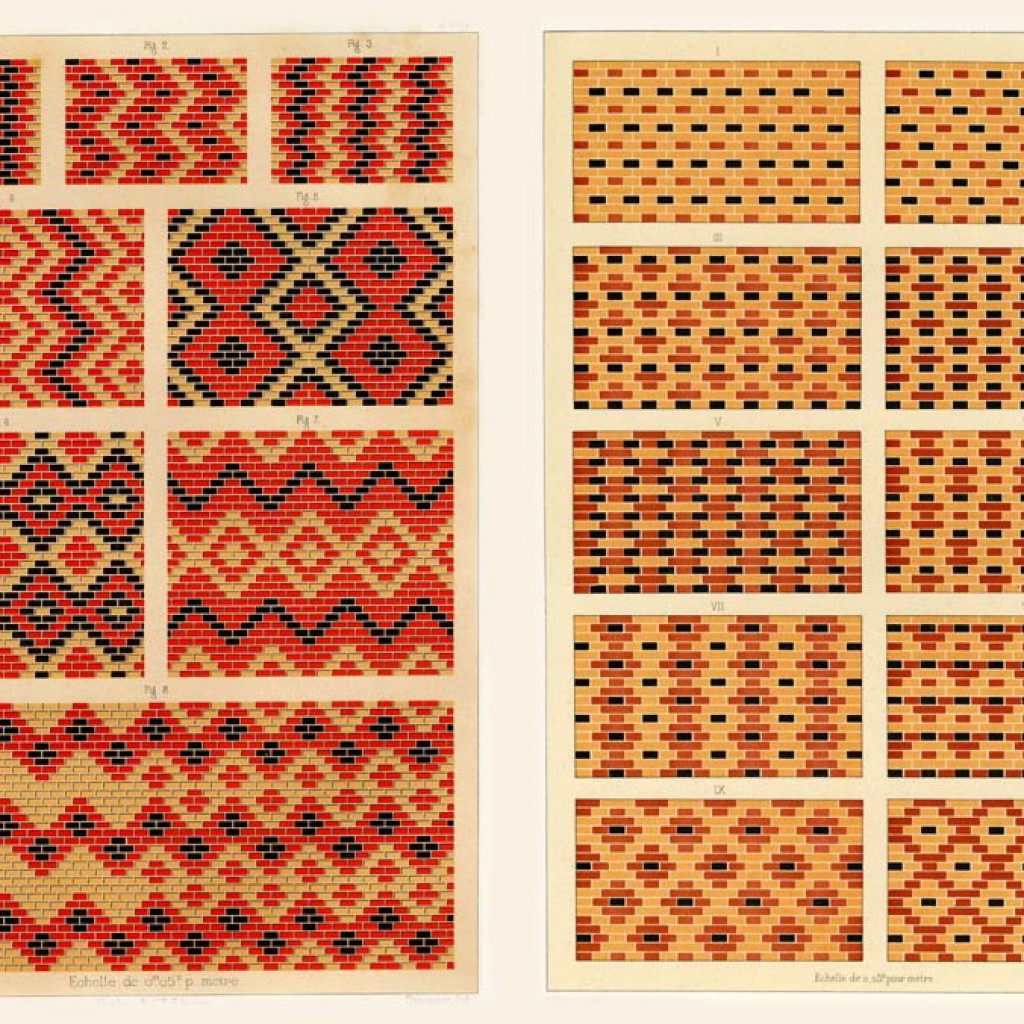
The ornament has long been considered a talisman. People willingly believed in the miraculous power of ornament and used it in every possible way in clothing, applied designs to dishes and, of course, added elements of ornament to the walls of houses.
Today, the ornament on the wall of a building is often created not through drawing, but using brickwork . The pattern of brickwork is very popular, it looks catchy, but in a combination of colors it looks pleasing to the eye.
Before giving preference to one or another ornament sign, study the meaning of the drawings. Take a closer look at which picture you like. It will not be difficult for a master to lay out an ornament of any complexity. The main thing for you is the harmony and aesthetics of the drawing. When choosing fragments of the ornament, remember that brickwork- not just a drawing, it is very difficult to redo it.
Examples of decorative brickwork
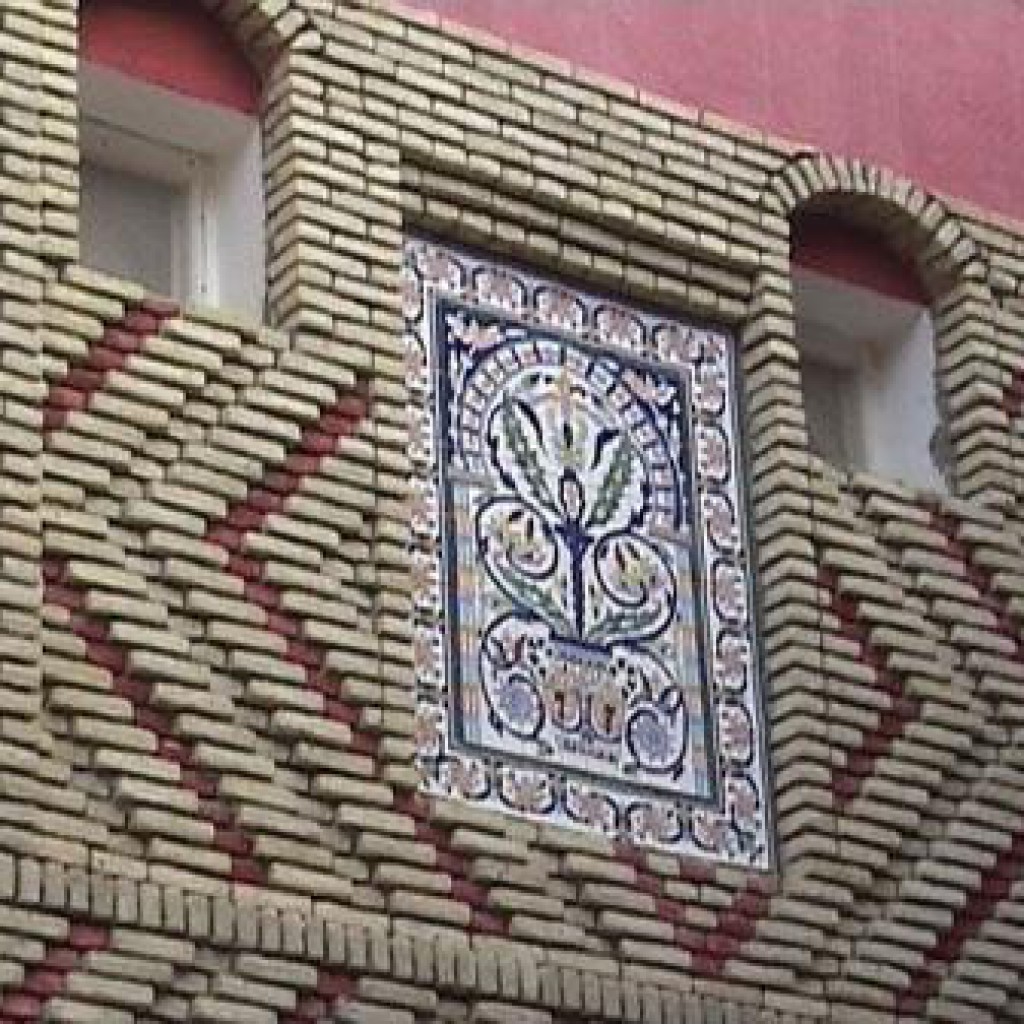
To correctly perceive the appearance of decorative brickwork, you can look at the brickwork patterns, photos of which are presented below:
These are the simplest of the patterns. You can create them at home with your own hands if you are at least a little familiar with general rules brick laying.
For more complex masonry modifications, it is worth contacting a specialist. In case you are unsure of your abilities. Relief patterns require certain skills and experience of a mason, but the appearance of such brickwork is very presentable.
Don't forget that decorative masonry will not only add originality to the facade of your home. Over time, it can become a local landmark, an example to follow and the admiration of guests.
Most owners prefer to use geometric patterns in façade design. The cost of laying simple geometric shapes is less than that of elaborate and intricate ornaments.
Brickwork patterns facing bricks are very popular in the construction environment. Using simple technology, you can lay out the facade and give the house a unique author's style. Facing brick has a very diverse range of colors, which allows you to expand the variations of decorative masonry.
If you still have questions, we recommend watching the video:
More on the topic:
- Brickwork: concept, types
- Materials and tools, work features
- Decorative facing brick
- Summing up
Brick is truly an amazing material. It has good quality and performance characteristics. Using a beautiful one, you can make the facade of your home truly unique. From the way the bricks are arranged in the masonry, they are formed various types drawings. Using your imagination, you can change the thickness and color of the seams, which will open up even greater scope for creating a truly unique facade.
A brick house is the most popular option for building from stone. A number of characteristics make it so: durability, reliability and safety. But in order for the house to be truly beautiful, you need to know how to skillfully make brickwork.
Brickwork: concept, types
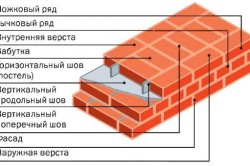
What is bricklaying? This is not only a high-quality construction of walls, but also an opportunity to show professionalism and imagination, to create an excellent texture load-bearing structures, create a drawing. What determines the complexity of building a brick house? As a rule, when answering this question, it is noted that it depends on the skills of the mason and the type of masonry he uses. If you have decided to create a fortress with your own hands, then you should thoroughly study the methods and techniques of making brickwork and choose the type of masonry that is most suitable for your case. And do not forget that good masonry is impossible without sufficient practical skill.
Before deciding on the type of brickwork and doing it yourself, you need to know the answers to several fundamental questions, namely:
The material used, in this case brick.
Brickwork is made from bricks and bonding material. As a rule, red and red bricks are used white flowers, ceramic and silicate, respectively.
There are several types, and their name varies depending on the composition (cement, mixed, lime, clay). The most popular is lime-cement.
There are several main types of brickwork:
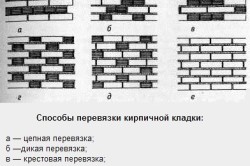
- Chain. It consists of alternating spoon and butt rows, with matching vertical seams of the spoons. That is, in odd rows the brick is placed with a spoon, in even rows - with a poke (done in 1.5 or 1 brick).
- Cross. Consists in the need to lay horizontal seams of spoon rows in a dressing. It differs from chain masonry in that the spoon rows move relative to each other.
- Dutch brickwork. When laying out a mixed row, tie and spoon bricks are laid one after the other.
- Gothic. Made entirely from mixed rows.
- English. The dressing is done in a certain size of brick, made from one tie row and two spoon rows.
- Multi-row brickwork with ligation. Ligation into a certain brick size, alternating a bonded and 4 spoon rows.
- Multi-row without dressing. There is no dressing of horizontal seams.
The types of brickwork listed above ensure structural strength and create a beautiful relief. This is achieved by combining different positions of the outer layer: protruding and angular.
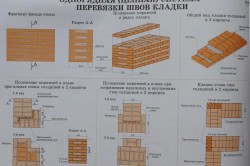
Chain ligation scheme.
What is the most important thing in creating a reliable design? The main thing is to correctly distribute the load. That is why masons always use time-tested brickwork dressings in their work:
- chain ligation: symmetrical closure of the lower seams;
- cross ligation: asymmetrical closure;
- Spoon ligation: asymmetrical half-length closure;
- multi-row dressing.
Return to contents
Materials and tools, work features
The quality of the material is the main condition for excellent masonry. When selecting a material, more precisely, a brick, first of all, it is necessary to pay attention to the correct shape of the product, the absence of cracks and various defects on it. The edges of the brick are certainly straight. Don’t forget about a well-chosen, high-quality mortar.
Before starting work, you need to prepare necessary tools for masonry:
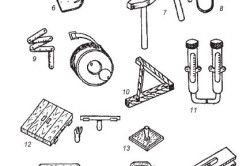
- Hammer-pick. Used for hewing and chopping bricks.
- Trowel (trowel). A spatula, the triangular shape of which is used for scooping up mixture and leveling.
- Tool for jointing (jointing). It is used to give the seam a certain profile.
- Plumb. Used to check the verticality of walls (200-600 g).
- Arrangement made of wood. Used to fix and mark masonry rows.
- Chalked cord. Used as a guide to ensure straight lines and horizontal rows when laying.
- Tape measures, buckets, shovels, containers for mixture.
The main stage before starting work on laying bricks is pouring the foundation and marking the contours of future walls. The chalk cord mentioned above will help with this. The recommended direction is “from left to right”. As a rule, they always start working from the corner. If we prepare about the sequence of work, then the following stages stand out:
- The first step is to spread mortar. It is applied with a shovel and leveled with a trowel.
- The next stage is laying the bricks. Having approached the marked mark, be sure to check whether the marking coincides with the top brick.
- Brick settlement. Once it is in place, the mason taps the top until it matches the lacing.
- Removing excess mixture. The solution squeezed out by tapping is picked up with a trowel and placed on top or between the joints.
After building a house, every owner wants to see his home attractive. To create a beautiful exterior, the building is finished with one of many facing materials, which include facing brick. However, you need to know that laying facing bricks with your own hands has its own characteristics and specifics.
Types of bricklaying
Compared to bricklaying methods when building a house, the types of cladding made from this material are very diverse. Types of facing brick masonry are classified according to different parameters. According to one of the classifications, masonry can be straight, artistic and decorative.
- When using direct masonry, bricks can be tied in different ways and combinations.
- Decorative cladding technology places emphasis on creating patterns. Designs are created by manipulating the color of the bricks and the location of the seams. When working on laying facing elements, you must constantly monitor the correctness of the resulting pattern.
- Artistic masonry is carried out according to a project previously drawn up by a specialist. With this technology, regulated different schemes seams, color combination of bricks and the type of laying of the facing material.

Masonry can be classified in another way. According to the location of the bricks in the wall, masonry is divided into the following types: cross type, path, Gothic type, block type, savage type, Brandenburg type.
House cladding rules
![]()
The outer walls of a house can be finished with many materials. However, finishing the facade with facing bricks requires a significant investment of time and labor. However, the final result pays for all the labor costs. Beautiful masonry facing bricks is not easy.
Pay attention! When carrying out work, precision and accuracy are required, and it is necessary to ensure the cleanliness of the front surface.
When working, you need to remember that the task of cladding is primarily to create a beautiful appearance for the home.
- It’s good if the base protrudes beyond the plane of the walls by 12 centimeters or more. This will make it easier to construct the first row of masonry. It must be laid out horizontally and checked with a level. First, the laying is done without the use of mortar. This fitting is necessary to select high-quality elements and correctly lay bricks in key places: in corners, as well as in window and door openings. At the initial stage, you already need to decide on the type of brickwork.
- Since the material is facing, it must be cut evenly. For this suitable for work a grinder with a special disk and certainly not an ax or hammer. The binding of the facing elements is made with cement mortar - the batch is based on cement, fine or sifted sand and water. To ensure that the mixture does not differ in color from bricks, dye is added to it. Since the solution dries quickly, you need to mix a small amount of it at one time.
- To avoid staining the front side of the cladding, a template is used when applying the solution. Thanks to it, the mixture does not reach the edge of the brick by about one and a half centimeters. To prevent the facing material from “floating”, the mortar for laying facing bricks must contain cement and sand in a ratio of ¼, then the mixture will be more rigid.
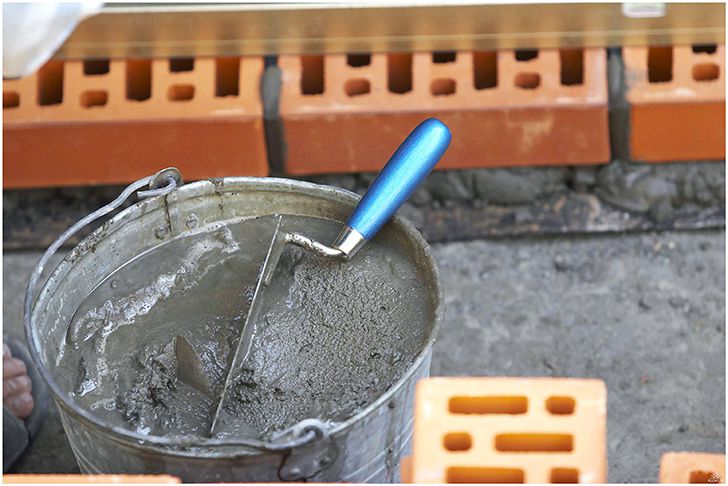
- First, the first row and joints in the corners are laid out over the base to a height of 5 bricks. Further laying is done along a thread stretched between the corners.
- When working with mortar, the front side of the cladding sometimes gets dirty, therefore, after laying out several rows, the surface of the wall is in certain places need to be wiped with a wet cloth.
- Next, the masonry is jointed by grouting the joints with a metal rectangular tool, and the excess mixture is removed. When properly grouted, the treated seam should not protrude beyond the plane of the wall. According to the rules, vertical seams should be up to 10 mm wide, and horizontal seams - up to 12 mm. To make the facing surface ventilated, at the very bottom, every 4 bricks, the seams are not sealed with mortar.
- Bricks must be tied during laying - this will allow the structure to be reliable and durable.
- The facing material in the area of windows and doors is laid with a poke. This creates a column the size of one brick.
Linking the finishing wall to the main one
The facing surface must be attached to the facade of the house. Otherwise, over time, the outer wall may collapse, shift and crack. There are many ways to tie the finishing layer to the main walls. For example, metal rods or plaster mesh can be used. In addition, you can use Ø6 mm dowels in combination with tie wire.
A wire is tied to the head of a dowel hammered into the wall, the ends of which are inserted into cement mortar. Such a binding should be organized every 4 bricks vertically.
Pay attention! Between facing wall and the main one should be a gap that will promote thermal insulation and ventilation.
The photo shows what the laying of facing bricks looks like.
Photo
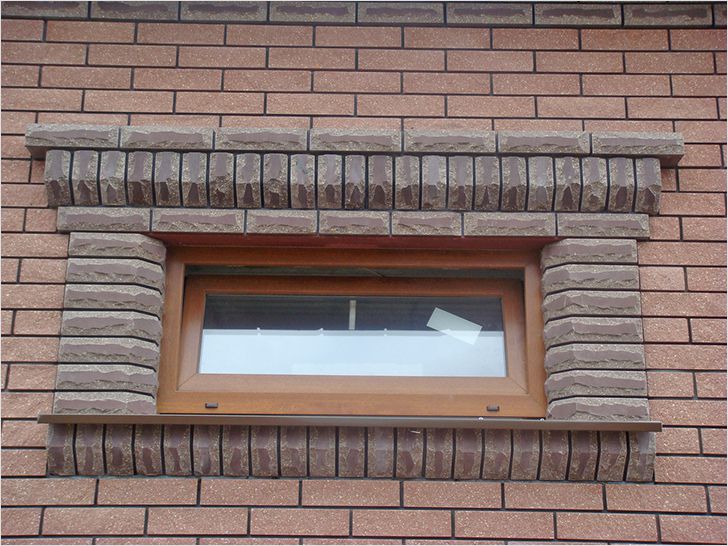
Brick is a fertile material; walls made of it are strong and durable. But this is not only its advantage. Over the centuries, building buildings from brick, man has learned how to paint three-dimensionally from this magnificent material.
Decorative masonry is the name of this process when walls are erected with various complicated parts in the form of original designs and ornaments. This type of masonry is extremely expressive from an artistic point of view.
Drawing in space
This pattern is created by experienced craftsmen using various combinations of bonded and spoon masonry, as well as various options shifts of bricks relative to each other.
The main types of facing bricks are:
- Gothic;
- Dutch;
- Silesian;
- tychkovaya;
- chain;
- Lipetsk;
- track;
- Brandenburg;
- savage or chaotic;
- cross;
- spoon (can be with an offset of 1/2 and ¼).
In each case, the pattern of brickwork differs in a different combination and order of laying bricks using the butt and spoon method. For example, in block and Lipetsk masonry, spoon and butt rows alternate regularly and the joints are all vertical, without shifts.
Important. For all types of cladding masonry, it is necessary to bandage the cladding masonry and the wall mass itself every 4–6 rows.
Drawing with color and texture
Modern industry produces bricks for finishing facades in various colors and even textures. wild stone on one of the spoon sides. These can be silicate products or clinker products, which are fired in kilns. Price sand-lime brick lower, but clinker is more durable.
The color scheme of these materials can be monochromatic or multi-colored. Decorative finishing of products in the form of “scratches” or “wild stone” allows you to diversify the facades of buildings.
The masonry is carried out using one of the well-known methods, but can be done in different colors. For example, tie rows are laid out in one color, and spoon rows in another. The seams with this cladding can be colored.
To do this, you can use ready-made colored solutions or fill the seams with a special solution that is produced for jointing. The seams are also formed in different ways, it depends on the architectural requirements. They can be made concave, convex or with a cut corner.
Relief drawing
To obtain relief masonry, some of the bricks are pushed out from the main plane of the wall, thereby obtaining three-dimensional patterns.
This method is often used for framing door and window openings, sandals, belts, external corners, cornices, niches and other structural and decorative elements of the facade
The overhangs are laid out in ledges, increasing the overhang as each next row is built. The width of the overhang should not be more than 1/3 of the length of the brick.
Important. The total removal of decorative unreinforced masonry can be no more than half the thickness of the wall.
If you need to make the takeout larger, then mandatory, it is necessary to make reinforcement with steel mesh.
Reinforcement parameters must be calculated in the project.
The ornament of decorative brick cladding usually consists of repeating geometric shapes, stylized motifs that are taken from nature or folk art can also be used.
Brick in the kitchen interior.
A very interesting recent trend in interior design is loft style design. It assumes the presence in the interior of unplastered brick wall. Such original chic.
But what if you have concrete walls at home, but you really like this style and want to match it? You can simply apply a brick pattern that is fashionable today on the walls or buy wallpaper with such a pattern.
Small step by step instructions will tell you how to make brick drawings on the walls with your own hands.
We will need:
- paint black and red for interior works;
- art paint gray and white;
- roller, brush;
- masking paper tape;
- level and lace.
Operating procedure:
- prepare the wall for painting;
- paint the entire surface of the wall where the black brickwork will be located;
- When the paint is dry, apply masking tape, dividing our wall into separate bricks;
- check how the markup turned out, everything should be smooth and neat;
- Next we draw the bricks themselves, painting the gaps between the tape with red paint and waiting for the paint to dry;
- We paint reliefs on the bricks with white and gray paint, this should be done with almost dry, but saturated with paint, brushes, try to give the bricks a natural look;
- remove the masking tape and touch up the paint carefully where necessary.
Resume
Brick has always been and remains today a favorite material for creating beautiful architectural forms, finishing facades, fences and interiors.
The video presented in this article will provide additional information on this topic.
 Comparative characteristics of the main types of economic systems
Comparative characteristics of the main types of economic systems Submit a corrective personal income tax return 3
Submit a corrective personal income tax return 3 A detailed list of documents for registration of privatization of an apartment, as well as the procedure for obtaining them
A detailed list of documents for registration of privatization of an apartment, as well as the procedure for obtaining them